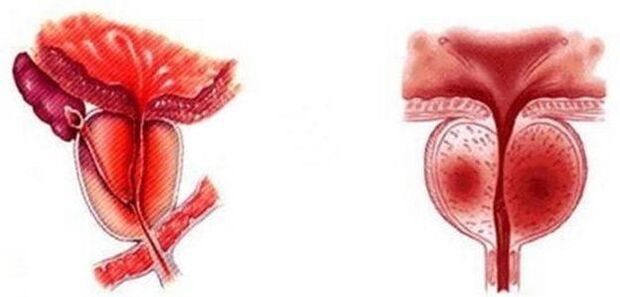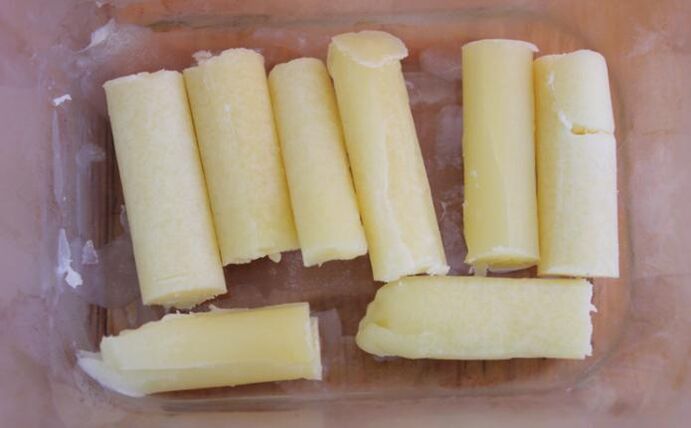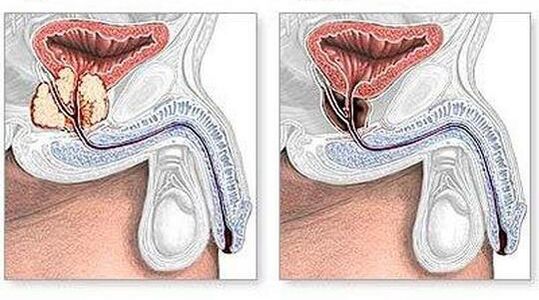
Chronic prostatitis (MKB-10 code. N41.1) is called an inflammatory process, which is observed for more than three months in the fabrics of the prostate gland.Its feature is that in almost 70% of all cases it proceeds without any symptoms.And only 15% of patients complain about the manifestations of the disease.All other men have symptoms that only partially indicate the development of prostatitis and can often contact other diseases.Therefore, it is so important when signs occur to see a doctor who, after examination, will tell you how to treat chronic prostatitis.
The peculiarity of the disease
Chronic prostatitis can diagnose not only in the elderly.Even young and medium people are subject to disease.At risk are those who lead a sedentary lifestyle, adhere to sexual abstinence or experience physical effort in the perineum.That is, the probability of chronic prostatitis in drivers, athletes is much higher than all the others.
Among all the diseases of the reproductive system of men, chronic prostatitis occupies the first place in the prevalence, followed by cancer and benign hyperplasia of the prostate gland of the DGPG (prostate adenoma).About every third man faces an inflammation of the prostate and every fifth of them suffers from a chronic form of the disease.
In most cases, the cause of chronic prostatitis are the transmitted diseases of the parental parent system caused by infections.A little less often, it is caused by inflammatory processes associated with a change in the hormonal background of a man.
Classification
Similarly to other inflammatory diseases, chronic prostatitis can have acute and chronic stages.Its classification is based on the following characteristics:
- The presence of leukocytes in the urine.
- The presence of pathogenic bacteria in the urine, ejaculate or the secret of the gland.
On the basis of the classification, there are the following types of disease:
- Asymptomatic inflammatory prostatitis is characterized by the lack of symptoms of chronic prostatitis.It is possible to identify it by chance when the patient faces a doctor with any other disease.
- Acute bacterial prostatitis.The patient has an acute inflammation of the prostate tissues, the pathogens are present in the urine, which lead to an increase in the temperature and development of the body's entrusting.
- Chronic bacterial prostatitis.The doctor notes the typical signs of chronic inflammation.And in the analysis of the urine and secret, the high content of leukocytes and bacteria is detected.
- Chronic pain syndrome in the pelvis.This pain is considered the main symptom, since bacteria are not detected.To make a diagnosis of chronic prostatitis, the syndrome should be observed in a man for at least 3 months.
Causes of the disease
The main cause of chronic prostatitis is the penetration of pathogens (enterococci, intestinal or prayer sticks, etc.) in the prostate gland, etc.).Go to the prostate, bacteria can be in three ways:
- Through the urethra.
- Through blood.
- Through the lymph.
According to statistics, 90% of cases of chronic prostatitis is a consequence of the development of acute prostatitis or a complication of urethritis.
In addition to entering a prostate of bacteria, the causes of chronic prostatitis can be the following:
- Sexual infections (Stpp): Herpes, Trichomonas, Gonococcus, Chlamydia, etc.
- Stagnation processes in the pelvic area, which can cause inflammation of the prostate.
- Reduce immunity.This can lead to: vitamin deficiency, violation of the balance of hormones, hypothermia, allergic reactions, significant physical and emotional stress, non -infected infections, etc.
- A sedentary lifestyle.
- Light weight.
- Irregular sex life or disturbances in the intimate sphere.
- Horse injuries.
- Wearing tight linen.
- Irrational nutrition (predominance in the diet of spicy foods).
- Coating for urination.
- Violation of the chair.
All this can lead to circulatory disorders in the pelvic area, contribute to stagnant phenomena and the development of the inflammatory process.The consequences of the lack of therapy are infertility and impotence.
Symptoms of the disease
The signs of chronic prostatitis can be very different.Very often, the patient complains of:
- Reduce performance.
- Quick fatigue.
- Increased irritability.
- Anxiety.
- Sleep violation.
- Letargia.
- Loss of appetite.
- Increase in sweating.
Among the local symptoms:
- Urination disorder.The patient feels frequent impulses, pain at the beginning and end of urination.
- A painful pain that can give in to the groin, the sacrum, the scrotum, the bone of the sublaio or to the rectum.
- Pain in sex.
- Tension exhaust of the pelvic muscles.
Unlike the acute phase, in a chronic disease, a violation of sexual functions often occurs.This is associated with the fact that the stagnant is also inflammatory processes, affects the nerve endings that provide the transmission of impulses to the brain.Consequently, a violation of an erection is possible, which weakens or ejaculation (premature ejaculation), the sensations during an orgasm (canceled orgasm) are opaque.These symptoms of chronic prostatitis in men lead to fear of closeness, irritability and, consequently, sexual neurosis develops.
It is not easy to treat chronic prostatitis.How long will have to take medicines depends on the degree of pathology and the duration of the development of the disease.It is important to remember that if the symptoms of the disease have disappeared, this does not mean a final cure.The serious consequences of chronic prostatitis include gland scars.This process can move on to the urethra.
Diagnosis of the disease
When they go to the doctor, he will ask the patient for the available symptoms.Particular attention is paid to the frequency and nature of pain, compromised urination, sexual dysfunction.But due to the fact that chronic prostatitis can occur without any manifestation, some studies are needed:
- Analysis of clinical and bacterial urine in which the quantity of leukocytes and the presence of pathogenic microorganisms are determined.
- Analysis of the secret that can contain bacteria.
- A scraping from the mucosa in which the quantity of leukocytes is determined, the presence of macrophages and amyloid bodies.
- Transureral ultrasound allows you to identify a chronic prostatitis echoblastic and determine the condition of the prostate.
High quality diagnosis is a significant part of the correct treatment, as it allows you to distinguish chronic prostatitis from other pathologies with similar signs.
Treatment
This disease should have an integrated therapy approach.In this case, the patient must tune in to a long treatment.The chronic prostatitis treatment regime will be individual for each patient.Usually, the patient does not need hospitalization and can be treated at home.A completely different question is when the acute phase of the disease or its exacerbation against the background of the chronic inflammation of the prostate is subject to treatment.In a hospital, antibacterial therapy is used and deintoxic is carried out.If necessary, an operation is required.
Drug therapy
For complete treatment of chronic prostatitis, drugs are prescribed in men, whose effect aims to eliminate infection, normalization of blood circulation and the level of hormones.To do this, use:
- Antibiotics.
- Anti -storidal anti -inflammatory drugs.
- Anticholinergic agents.
- Immunomodulators.
- Angioprotectors.
- Vasodilatory medicines.
Before making an appointment, the doctor will analyze the pathogen.If the disease is not a bacterial origin, the course of antibiotic therapy will be short.In the event that it is not possible to determine the type of pathological microflora with laboratory methods, an histological analysis of the prostate tissue is used.
With the impact of the disease, antibacterial therapy is prescribed for prevention purposes.For this, a drug is used, which was already used during treatment, but in a lower dosage.
Knowing what chronic prostatitis is and what can cause its development, the specialist will pay attention to the pressure within the prostate gland and its ability to reduce.If this function is reduced, stagnant phenomena and prostate inflammation can occur in the basin.The alpha-blockers are prescribed to normalize intrauterine pressure.
You can avoid painful injections and take pills using a candle.
For complaints about rapid and painful urination, nonsteroidal anti-inflammatory drugs are used in combination with alpha-blockers.
In the event that the intake of antibiotics proved to be ineffective and symptoms such as pain and dysuria are preserved, the treatment is regulated in order to say on:
- Elimination of pain.To do this, use tricyclic antidepressants.
- Normalization of urination.The treatment is prescribed after urinodynamic analysis.With the hyperactivity of the sphincter, antihistamines, tricyclic antidepressants and the rinse of the bladder with antiseptic solutions are indicated.With the ineffectiveness of this treatment, neuromodulation and physiotherapy are used.
Non -pharmacological methods
In order for the treatment with tablets to be more effective, the doctor may recommend physiotherapy (electrophoresis, sound phonoforesis, laser therapy, mud treatment) and transrettal hyperthermia, which is performed taking into account the existing changes in the tissue of the prostate and related diseases.If exposed to a temperature of 40 degrees, cell immunity is activated.If exposed to a temperature of 45 degrees, the inhibition of nerve endings occurs, which helps to stop pain.The use of laser therapy has a biostimulating effect.
In the absence of contraindications, the patient is performed by the prostate gland.Patients are often prescribed a psychotherapy course and special exercises that can strengthen the perineum muscles.
Treatment with popular remedies
Together with the use of medicines, the manifestations of chronic prostatitis are treated with popular methods.This treatment increases immunity and reduces pain.For this, in addition to preparations based on herbs, infusions and decoctions of herbs, bathrooms, etc.They are used.
The course of plant treatment is at least 1 month and should be prescribed by a doctor, since some of them may have contraindications for use.Treatment with folk methods suggests:
- Abundant drink (tea with Linden, Rosarship, Lamponi).
- Every day before meals, you have to drink 1 glass of freshly squeezed carrot, pear, cucumber juice.
- If the patient is tormented by pain, coniferous baths are used, a temperature of 37 degrees.The duration of the procedure is 20 minutes.
- If the patient does not have a honey allergy, it is recommended to eat up to 100 grams of product every day.
- At home, you can independently do the suppositories based on propolis or honey.You have to put them within 1 month.To prepare the candles with Propolis, take a mixture of glycerol, jelly and water in proportions of 5: 1: 2. Add propolis there and distribute the mixture on the parchment.Put everything in the refrigerator, where the suppositories are completely frozen.
- Before going to bed, it is recommended to create an enema with Wormwood.To do this, 1 teaspoon of dry plants is prepared in 1 liter of boiling water.

Treatment with pumpkin seeds, aloe juice, parsley, chestnuts and curtains is also considered effective.The parsley has an anti -inflammatory effect and is able to restore sexual function.Phytotherapists recommend this treatment with this plant:
- Drink 1 tablespoon of parsley juice every day before meals.
- 4 teaspoons of vegetable seeds pour 250 ml of boiling water and insisted on the Thermos for the night.The next day they drink an infusion of 1 tablespoon every hour.
- 100 g of the crushed root of the plant are poured with 1 liter of water, put a slow and boiled fire for 10 minutes.A decoction is drunk during the day.
An effective tool are pumpkin seeds.About 30 of these seeds contain a daily dose of zinc, necessary for male health.For treatment, you can make such a tool.500 g of pumpkin seeds are crushed in a flesh -fired grid and mixed with 200 grams of natural honey.The balls are made by the resulting mass, the size of a walnut.Every day you have to eat 2 balls of these.
Propolis helps to strengthen body defenses and relieve inflammation.You can buy his tincture in a pharmacy.For the treatment, you need to drink a glass of milk every day with 1 teaspoon of that tincture.
Furthermore, the eco -budding of Liquorice, the Echinacea grass are used for treatment, which are also used in cases where the disease occurs without evident symptoms.
Surgery
Often, chronic prostatitis does not provide symptoms and patients seek medical assistance when serious changes have occurred in the prostate gland and chronic prostatitis is already helpless.In addition, these complications can represent a threat to patient health.An example of complication can be called prostate sclerosis.
Due to the fact that these complications are often revealed in young people, doctors use minimally invasive surgery.The indication for its use is: phimosis, involuntary release of urine or, on the contrary, its delay, prostate abscess, a significant increase in the gland of size, urethral block or bleeding.There are types of surgical interventions indicated for chronic inflammation:
- CIRCOMCIA - It is used when the patient has phimosis.During the operation, the foreskin is sectioned.
- Prostatectomy is a radical operation during which the prostate is completely removed.It is carried out in case of suspicion of the presence of a malignant tumor.
- The reset of the prostate is a partial removal of the gland, in the case of its sclerotic change.
- Elimination of adhesions.
- Drainage of a cyst or abscess.It is produced by endoscopy.For drainage, a special tube is used with a camera at the end.This device is introduced into the ignitra lumen and allows you to check the course of the operation.
- In the case of complaints of various sexual disorders (violation of orgasm, painful ejaculation, etc.), the patient is carried out by an incision of the Erystormal ducts.

The result of the surgical intervention will depend on the timeliness of the diagnosis.In cases where there is a prostate adenoma, chronic prostatitis manifestations can be lubricated.This is observed in 70% of cases.25% of men learn the development of chronic prostatitis during an adenoma exam.And only 5 % of patients - during a preventive exam.
The condition for the operation is the lack of an effect with the conservative treatment of the disease.Therefore, the operation is necessary to prevent complications and improve the quality of life.
However, it must be borne in mind that even after surgery it is possible to return prostatitis.This happens in almost half of those operated.The contraindication to any operation is:
- Diabetes.
- Liver pathology.
- Respiratory system diseases.
- Mental disorders.
- Cardiopathy.
The prognosis of the disease
Anyone who is faced with this diagnosis is interested in the fact that chronic prostatitis can be treated?The disease is considered curated if the symptoms do not seem a significant period of time, the level of leukocytes in the urine is normally, in the secret of the prostate there are no pathogenic bacteria, urination and sexual function are restored.
Very often, the prognosis is favorable in cases where the disease has not led to irreversible processes and the patient observes the prescribed treatment.
Disease prevention
Each medium -age man should prevent the prevention of diseases of the -common parent system, which will also contribute to reducing the probability of chronic prostatitis.Enough for this:
- Adhering to the foundations of a healthy lifestyle, practice sports.
- Eat well.It is important to consume many protein foods (low fat and fish meat, dairy products -caseari, eggs) and limit the amount of animal fats.At the same time, canned foods, sharp and salty dishes, alcohol should be excluded from the menu.
- Regular sex life.It is important to avoid unprotected sex.
In order to prevent prostate disease, every man, especially after 35 years, must monitor health and lead an active life.It is not necessary to ignore a medical exam, which always helps to identify prostatitis over time and start treatment.It is important to remember that it is treated if it is detected in the initial phase and the patient observes all the prescriptions of the doctor.
























